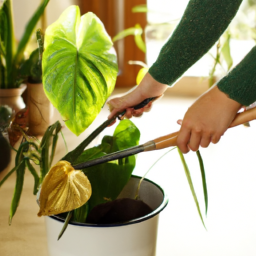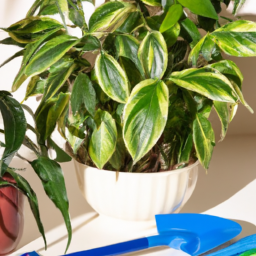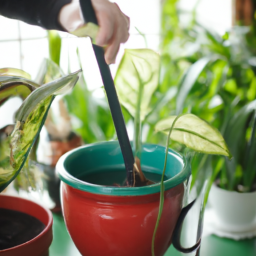
Hey there plant lovers! Today, we’re going to delve into a topic that often leaves indoor gardeners scratching their heads: should indoor plants be repotted? Whether you’re a seasoned plant parent or just starting out on your green thumb journey, this question is bound to cross your mind at some point. Repotting can be a daunting task, but fear not! In this blog post, we’ll explore the reasons why repotting may or may not be necessary for your beloved leafy companions. So grab your favorite mug of tea, find a cozy spot, and let’s dive into the wonderful world of indoor plant repotting!
Benefits of Repotting Indoor Plants
Indoor plants are not only a beautiful addition to our homes but also provide numerous benefits, including improved air quality and a sense of tranquility. However, as plants grow, their roots may outgrow their current containers, leading to a need for repotting. In this article, we will explore the benefits of repotting indoor plants and guide you through the process.
Improved Growth and Health
One of the primary reasons to repot indoor plants is to promote their growth and overall health. Over time, plants can become root-bound, meaning their roots have filled the current container and have no room to expand. This can lead to stunted growth, as the plant struggles to access sufficient nutrients and water.
By repotting, you provide your indoor plant with a fresh start and a larger container that allows its roots to spread and grow. This promotes healthier root development, leading to improved nutrient absorption and water retention. As a result, your plant will experience enhanced growth, with lusher foliage and more vibrant blooms.
Additionally, repotting allows you to inspect the roots for any signs of disease or pest infestation. By catching these issues early on, you can take appropriate measures to protect your plant and prevent further damage.
Preventing Nutrient Depletion
As plants grow, they naturally consume the nutrients available in their potting soil. Over time, these nutrients become depleted, and the soil loses its fertility. Repotting provides an opportunity to replenish the nutrient content of the soil and ensure your indoor plant has access to the necessary elements for optimal growth.
When repotting, it is recommended to use a high-quality potting mix specifically formulated for indoor plants. These mixes often contain a balanced blend of organic matter, such as compost and peat moss, along with essential nutrients like nitrogen, phosphorus, and potassium. By providing your plant with fresh, nutrient-rich soil, you give it the best chance to thrive.
Furthermore, repotting allows you to remove any compacted or clumped soil that may hinder proper drainage. Good drainage is essential to prevent waterlogging and root rot, which can be detrimental to your plant’s health.
Encouraging Aesthetic Upkeep
Repotting your indoor plants also presents an opportunity to refresh their appearance and enhance the overall aesthetic of your space. Over time, plants may become leggy or develop uneven growth due to limited space in their current containers.
By repotting, you can carefully trim and prune the roots, removing any dead or damaged portions. This helps to stimulate new root growth and encourages a more balanced and compact plant structure. Additionally, you can trim back any overgrown foliage, promoting a fuller and more visually appealing appearance.
Furthermore, repotting allows you to choose a new container that complements your interior design and accommodates the size of your plant. You can select a pot that not only provides ample space for root growth but also adds a decorative element to your living space.
Remember to choose a pot with drainage holes to prevent water accumulation and potential root problems. If you opt for a decorative pot without drainage, consider using a plastic liner or adding a layer of rocks at the bottom to facilitate proper drainage.
In conclusion, repotting indoor plants offers numerous benefits, including improved growth and health, prevention of nutrient depletion, and aesthetic upkeep. By providing your plants with fresh soil, room for root expansion, and a visually appealing container, you can ensure their well-being and enhance the beauty of your indoor space. So, if you notice your indoor plants outgrowing their current pots or displaying signs of nutrient deficiency, it may be time to embark on the repotting journey.

Signs that Indicate Indoor Plants Need Repotting
Indoor plants not only enhance the aesthetic appeal of your living space but also provide numerous health benefits. However, just like any living organism, plants require proper care and attention to thrive. One crucial aspect of plant care is repotting. Repotting is the process of transferring a plant to a larger container or replacing its soil to provide it with enough space and nutrients to grow. But how do you know when it’s time to repot your indoor plants? In this article, we will discuss the signs that indicate your indoor plants need repotting.
1. Root Bound Plants
One of the most common signs that your indoor plants need repotting is when they become root bound. Root bound plants occur when the roots outgrow the current container, causing them to become tightly packed and entangled. You may notice that the roots are circling around the edges of the pot or even growing out of the drainage holes.
Root bound plants face several issues. Firstly, the tightly packed roots restrict the plant’s ability to absorb water and nutrients from the soil, leading to stunted growth. Secondly, the lack of space hampers the plant’s overall health and can even result in root rot. Therefore, if you observe any signs of root binding, it’s time to repot your indoor plant.
When repotting root bound plants, gently loosen the roots with your fingers or a tool to encourage new growth. Choose a container that is one to two sizes larger than the current one, ensuring it has proper drainage. Fill the new container with fresh potting soil and carefully place the plant, covering the roots with soil. Water the plant thoroughly and place it in its new home.
2. Slow Growth or Wilting
If your indoor plant is experiencing slow growth or wilting, it may be a sign that it needs repotting. Over time, the nutrients in the soil become depleted, and the plant’s roots may struggle to access them. This can result in a lack of essential nutrients, leading to stunted growth or wilting leaves.
Additionally, if the soil becomes compacted or waterlogged, it can prevent proper drainage and oxygenation of the roots. This can suffocate the plant, causing it to wilt or show signs of stress.
When repotting a plant due to slow growth or wilting, carefully remove it from its current container and inspect the roots. Trim any damaged or rotten roots and gently loosen the remaining ones. Choose a new pot with good drainage and fill it with fresh, well-draining potting soil. Place the plant in the new pot, making sure the roots are adequately covered with soil. Water the plant thoroughly and provide it with the appropriate amount of light and water for its species.
3. Excessive Watering or Drainage Issues
Overwatering is a common mistake made by many indoor plant owners. If you notice that your plant’s soil is consistently wet or waterlogged, it may be a sign that the current potting mix is not draining properly. Poor drainage can lead to root rot and other fungal diseases, compromising the plant’s health.
When repotting due to excessive watering or drainage issues, carefully remove the plant from its current container and examine the roots. Trim any rotten or damaged roots and check the condition of the soil. If the soil appears compacted or waterlogged, it’s time to repot the plant.
Choose a new pot with adequate drainage holes and fill it with fresh, well-draining potting mix. Place the plant in the new pot, ensuring the roots are properly covered with soil. Water the plant thoroughly and allow any excess water to drain away. Adjust your watering routine to prevent overwatering in the future.
Repotting your indoor plants is an essential part of their care routine. By understanding the signs that indicate your plants need repotting, you can ensure their continued health and growth. Remember to choose the right pot size, provide proper drainage, and use high-quality potting soil to give your indoor plants the best chance to thrive.

Step-by-Step Guide to Repotting Indoor Plants
Indoor plants not only add beauty to our homes but also provide numerous health benefits. However, as they grow, they may outgrow their pots and require repotting to ensure their continued growth and well-being. Repotting indoor plants can be a daunting task for many, but with the right approach and knowledge, it can be a rewarding experience. In this guide, we will walk you through the step-by-step process of repotting your indoor plants.
1. Assessing the Need for Repotting
The first step in repotting indoor plants is to assess whether they actually need repotting. There are a few signs that indicate it’s time to repot your plant:
Root Bound: If you notice roots growing out of the drainage holes or circling around the surface of the soil, it’s a clear indication that your plant has become root bound and needs more space.
Stunted Growth: If your plant is not growing as vigorously as it used to, it may be due to lack of nutrients or limited space for root expansion.
Watering Difficulties: If the water quickly runs through the pot without being absorbed by the soil, it could be a sign that the roots have taken up most of the space, leaving little room for water retention.
Once you have identified one or more of these signs, it’s time to proceed to the next step.
2. Gathering the Necessary Tools and Materials
Before you start repotting, gather all the necessary tools and materials:
Pot: Select a pot that is one size larger than the current pot. Make sure it has drainage holes to prevent waterlogging.
Potting Mix: Choose a well-draining potting mix suitable for your plant type. Avoid using garden soil as it may contain pests or diseases.
Trowel or Garden Spade: Use a trowel or garden spade to carefully remove the plant from its current pot.
Pruning Shears: If necessary, have pruning shears handy to trim any overgrown or damaged roots.
Watering Can: Prepare a watering can filled with water to hydrate the plant after repotting.
3. Repotting Process
Now that you have everything ready, it’s time to repot your indoor plant. Follow these steps:
Step 1: Moisten the potting mix before repotting. This will help the roots adjust to their new environment more easily.
Step 2: Carefully remove the plant from its current pot. Gently tap the pot’s sides or use a trowel to loosen the soil and roots.
Step 3: Inspect the root system. If you notice any damaged or diseased roots, trim them using clean pruning shears.
Step 4: Place a layer of fresh potting mix at the bottom of the new pot. This will provide a nutrient-rich foundation for the plant.
Step 5: Position the plant in the center of the new pot, ensuring it sits at the same depth as it did in the previous pot.
Step 6: Fill the remaining space around the plant with fresh potting mix, gently pressing it down to eliminate air pockets.
Step 7: Water the plant thoroughly until water drains out of the bottom of the pot. This ensures that the roots are well-hydrated.
Step 8: Place the newly repotted plant in a suitable location with appropriate light and temperature conditions for its specific needs.
Remember to water your repotted plant regularly and monitor its growth and overall health. Repotting is usually recommended every 1-2 years, depending on the plant’s growth rate. However, some plants may require repotting more frequently, while others may thrive in slightly crowded conditions.
By following this step-by-step guide, you can ensure that your indoor plants have enough space to grow and flourish, promoting their overall well-being and enhancing the beauty of your home.
Here’s what we learned
Indoor plants are a popular addition to any home, bringing a touch of nature and a sense of tranquility. But as they grow, many plant owners may wonder if it’s necessary to repot their leafy companions. Well, the answer isn’t a simple yes or no. It depends on various factors, such as the type of plant, its size, and the condition of its current pot.
Firstly, let’s consider the size of the plant. If your plant has outgrown its pot, with roots poking out from the drainage holes or circling around the base, it’s a clear sign that repotting is in order. This is because when the roots become cramped, they struggle to absorb water and nutrients, hindering the plant’s growth. Additionally, a larger pot provides more room for the roots to spread out, promoting a healthier and more stable plant. On the other hand, if your plant is still small and doesn’t show any signs of root congestion, repotting might not be necessary at the moment.
Another factor to consider is the condition of the current pot. If the pot is cracked, chipped, or doesn’t have proper drainage, it’s advisable to repot your plant. These issues can lead to waterlogged soil, causing root rot and eventually killing the plant. However, if the pot is in good condition and provides adequate drainage, you can simply refresh the soil by removing the top layer and replacing it with fresh potting mix. Remember, though, that even if your plant doesn’t need immediate repotting, it’s still crucial to regularly check its roots and monitor its growth. With a little bit of attention and care, your indoor plants will thrive and continue to bring life to your living space.
Frequently Asked Questions (FAQ):
Q1: Should indoor plants be repotted?
A1: Yes, indoor plants should be repotted periodically to ensure their health and growth. Over time, plants outgrow their pots, deplete nutrients in the soil, and become root-bound. Repotting allows them to have enough space for their roots to grow, access fresh nutrients, and maintain overall vitality.
Q2: How often should indoor plants be repotted?
A2: The frequency of repotting indoor plants depends on various factors such as the plant species, pot size, and growth rate. As a general guideline, most indoor plants benefit from repotting every 1-2 years. However, some fast-growing plants may require repotting annually, while slower-growing ones may only need it every 2-3 years.
Q3: What are the signs that indicate a plant needs repotting?
A3: There are several signs to look out for that indicate a plant needs repotting. These include roots growing out of the drainage holes, roots circling around the pot, stunted growth, yellowing or wilting leaves despite proper care, and the plant becoming top-heavy or tipping over easily. If you notice any of these signs, it’s time to repot your indoor plant.
Q4: How do I repot an indoor plant?
A4: To repot an indoor plant, follow these steps:
1. Select a slightly larger pot with drainage holes.
2. Prepare a well-draining potting mix suitable for your plant.
3. Gently remove the plant from its current pot, loosening the roots if necessary.
4. Place a layer of fresh potting mix at the bottom of the new pot.
5. Position the plant in the center of the pot and fill the remaining space with potting mix, ensuring the plant is at the same depth as before.
6. Firmly press the soil around the plant to eliminate air pockets.
7. Water the plant thoroughly and place it in its designated spot.
Remember to research specific repotting requirements for your plant species, as some may have unique needs.
Q5: Can I repot my indoor plant at any time of the year?
A5: While repotting can generally be done at any time of the year, it’s best to repot indoor plants during their active growth phase, which is typically in spring or early summer. This allows the plant to recover quickly and adapt to its new environment. However, if your plant is showing signs of distress or outgrowing its pot, it’s better to repot it promptly, regardless of the season.

James Wong is a renowned ethnobotanist, plant scientist, and local television presenter. With a passion for demystifying plant science, he is known for translating complex botanical concepts into practical advice for everyday plant enthusiasts. James’s expertise spans from traditional gardening to cutting-edge plant technologies, making his insights accessible and informative.


